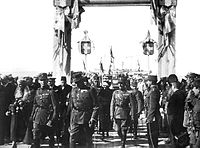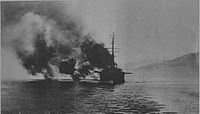User:Sandoria/Sandbox3
| November Events | |||||||
|---|---|---|---|---|---|---|---|
 Council of military coup commanders after taking over Ocerto | |||||||
| |||||||
| Belligerents | |||||||
Support: |
Support: | ||||||
| Commanders and leaders | |||||||
|
Xulio Sousa Otávio Henriques Oscar Carvalho |
[Carlos Palmeira]] Roberta II Joaquim Fidalgo Bruno Lavigne | ||||||
The Eventos de Novembro ("November Events"), or the 1925 Paretian coup, was a political dispute that culminated in the takeover of Paretia by the New Nation of Paretia Party and Carlos Palmeira. It lasted from August to November 1925. It saw the conflict between liberal supporters of Xulio Sousa, the elected Premier of Paretia in the 1925 election, and the functionalist supporters of Palmeira, supported by Queen Roberta II. The coup was lead by the monarchy, pro-functionalist military, and Gaullican forces. Gaullican troops would occupy parts of Paretia and shut down ports to help facitate the coup.
Background
After the Great Collapse halted to Turno Tranquilo and economic progress and modernisation halted in Paretia, radicalisation grew immensely as left-wing groups like the Paretian Section of the Workers' International, the New Nation of Paretia Party, and others who wanted to turn Paretia away from the liberal democracy that it had established under Túlio Serras and the LNRM. The LNRM had splintered into centre-right and centre-left sides, eventually dissolving. The rise of numerous parties eyeing power lead to electoral alliances forming in the multi-party system.
After the death of Lourenço III in 1921, his daughter, Roberta II, a staunch supporter for the National functionalist PNNP came to power, further pushing for supporting it's charismatic leader, Carlos Palmeira. Many liberal, sotirian democratic, and social democratic parties united into or allied with the Democratic Party of Paretia, under the leadership of charismatic Xulio Sousa. The next election was mainly between the PNNP, PDP, and SPIO.
Events
Election
By 1925 the Paretian atmosphere was already in turmoil, like Etruria, Paretia was indecisive over aligning with Gaullica and the Entente, or Estmere and their allies, as global tensions began to rise. By the 1925 election many voters either sided with the liberal big-tent Democratic Party of Paretia and their alliance, or the New Nation of Paretia Party, and allies.
The 1925 Paretian election saw the victory of Sousa and the PDP-led alliance by a slim margin against the PNNP. The PDP would also allied with Paretian Section of the Workers' International in forming a government. Carlos Palmeira objected to the results and called upon the people the protest the election. Queen Roberta II, a devout functionalist and leader in the PNNP, also refused to appoint Sousa officially as Premier.
Conflict
In August 1925 protests would erupt in many cities, with lots of them initially being pro-functionalist, with counterprotests being mostly pro-Sousa in support of the new government. Roberta II would eventually appoint Sousa due to threats by the PDP-run Senate to strip her of powers. The government would attempt to reform the military to rid of functionalist support and would attempt to ban functionalist paramilitaries, this however was not seen through.
Street brawls became much more violent, they already had been on the rise in the previous months, but the violence reached a tipping point during August to November 1925. Paramilitaries such as the Army of the New Nation would be used to fight protesters in support of Sousa, and the fairly pro-functionalist police and military stood back during these attacks. Many civilians would be hurt in these protests, as they included physical violence, firebombings, and other attacks.
The protests would continue into September and October as Palmeira continued to fan the flames against Sousa. Roberta II and pro-functionalist military leaders met to plan to take over the government, and would secretly plan to work with functionalist Gaullican forces. General Joaquim Fidalgo would go to Gaullica to meet with the Admiral of the Gaullican Fleeet, Bruno Lavigne, to plan their involvement in the upcoming coup. The monarchy of Roberta II would use their wealth to bribe police units and grendamarie from stopping the coup as well. Sousa ignored warning signs as the unrest continued.
Coup
The planning of the coup took place throughout late October into early November, Gaullican ships left port on November 5th. On November 7th Pro-functionalist Paretian officers and troops take over their barracks and mobilize into numerous cities across Paretia. They would arrest pro-Sousa officers and troops in their forces.
The coup forces would take over Precea's government district in the morning of November 7th, arresting members of the PDP and SPIO in the Senate of Paretia. The members of the PDP were sent to a camp to be watched, while members of the SPIO, which the PNNP thought as a greater threat, were taken behind the Senate and executed. Primavera Palace was taken over after, and Sousa arrested. He would be sent to Palacio do Solo, the royal palace.
Elsewhere, members of the New Nation of Paretia Party's paramilitary, the Army of the Newe Nation, and monarchist militias known as the Obrigé would take over rural areas. Many civilians accused of being enemies of the party were killed by these militias and paramilitaries in these rural takeovers. Many of the other major cities were taken over by military.
Gaullican troops would enter Tosutonia and occupy areas like Encerosa and Comteís. Gaullican marines would land on the coast of Paretia from Montecara and occupy coastal ports and cities to stop any escapees. In Pancarta, Gaullican ships would fire upon an attempted escape by loyalist troops to Emessa, sinking them. By the end of the day the functionalists had complete control of Paretia. Xulio Sousa would be exiled to Etruria by Roberta II and so were many of his allies.
Other PDP members remained in jail, some PDP, SPIO, and loyalist military elements escaped into the countryside such as the western mountains and joined together to form a resistance.
Aftermath
After the takeover by the military, Palmeira would go to Precea to be appointed and sworn in as the new Premier of Paretia by Roberta II. Palmeira would then announced the formation of an alliance between the PNNP and other nationalist and monarchist movements in Paretia such as the Obrigé and National Catholic movements. They would then form the new government, known as the 7th of November Movement, named after the date of the coup, ushering in the era of Functionalist Paretia.
Many SPIO members were publically hanged in Precea afterwards. With show trials of PDP members taking place as well, many of them sentenced to life in prison. Gaullica would send even larger numbers of troops to help put down resistance movements in the more-left leaning regions of Tosutonia and Esmeira. They would establish a military presence across Paretia and were accused of being occupiers by Gallophobe Etrurian elements. Gaullica would declare an alliance with the new Paretian government.
The international reaction saw criticism from Estmere, Werania, and Valduvia. Whilst it saw support and embrace from Ardesia, Amathia, and Shangea. In Etruria, the coup would become the biggest catalyst to Etruria's involvement with the Grand Alliance in the coming war, the favor of the Gallophile elements of Etruria's government fell out as fear of Paretian expansionist sentiment rose, especially over Emessa, which Palmeira had supported taking. The event further rose global tensions that culminated into the Great War.





